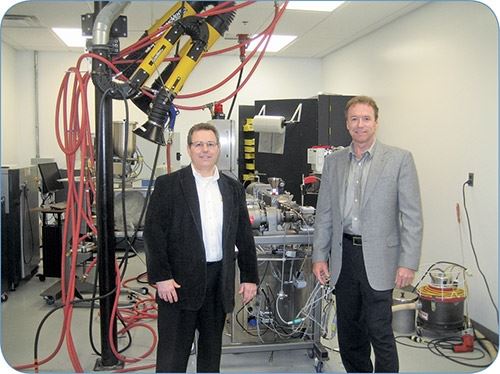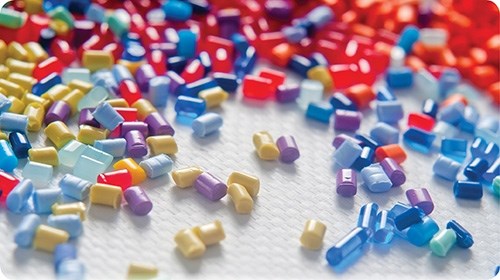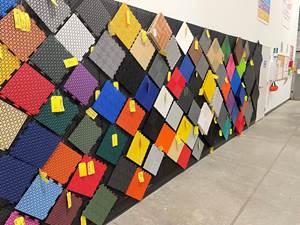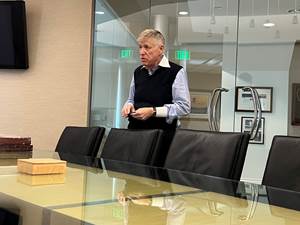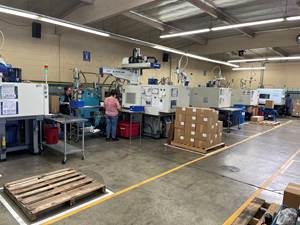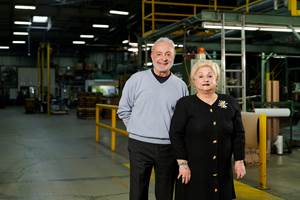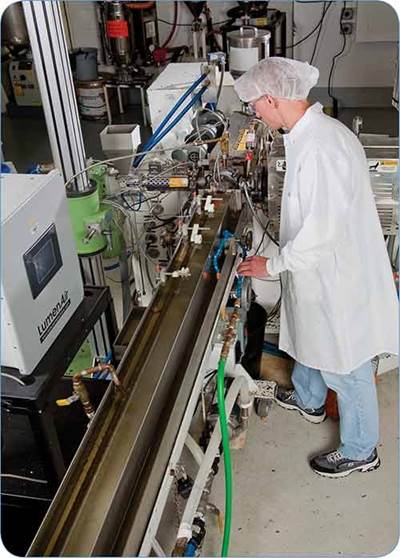On Site: Tailoring Medical Solutions… Sometimes in 50-lb Lots
Smaller volumes teams with higher quality and value as keys to the success of this growing medical compounder.
If you wanted to start a compounding business 20 or so years ago, you likely had two broad choices: Get into the high-volume commodity business and go toe-to-toe with well-established, financially strong competitors; or carve a specialty niche in an emerging field where premiums would be placed on high value and innovation.
In 1989, if Lawrence Acquarulo had had a Magic 8 Ball and asked it if he should get into medical compounding, the answer would have been “Outlook Good.” Today, when plastics processors of all types are looking to gain or expand medical business due to its relative insulation from wild business fluctuations, Acquarulo is CEO of a two-plant medical compounding operation that focuses on supplying high-value, highly customized materials for minimally invasive and non-invasive applications.
The story of Foster Corp. based in Putnam, Conn., tracks closely with that of sister company Putnam Plastics in Dayville, Conn. Acquarulo and partner James Dandeneau of Putnam—both graduates of the Univ. of Mass. Lowell’s plastics engineering program—each identified a niche and started in small, “garage”-type plants. Like Putnam Plastics, Foster has expanded significantly, from a 2500-ft², single-machine operation in Putnam in 1989 to a state-of-the-art, 65,000-ft² facility with 85 employees—together with a sister plant in Las Vegas.
Today, Foster is one of North America’s largest suppliers of compounds for minimally invasive medical devices, mainly catheters for interventional radiology and cardiology. “In 1989 we were certainly ahead of the curve,” remarks Acquarulo, who before he launched his own company worked for Imperial Chemical Industries (ICI) and LNP Engineering Plastics. “We learned a lot about physical properties and flow characteristics of materials back then. The medical-device market was just starting to emerge, and we saw an opportunity to start a business where quality and value were premiums.”
Foster has also gone where few, if any, plastics compounder have gone before—into the drug-delivery business, where it has brought its expertise in twin-screw extrusion to pharmaceutical manufacturing.
In its two facilities, Foster runs an undisclosed number of twin-screw extruders and also some single-screw machines, primarily for TPU. Foster also uses dehumidifying hopper dryers, along with dehumidifying and non-dehumidifying tray-oven dryers, to ensure materials are properly prepared prior to melt blending.
Blending is a critical component of Foster’s value position, as it allows the compounder to “dial in” additives precisely, depending on the requirement of the compound, says Acquarulo. Sophisticated material blending and feeding technologies include high-intensity premixers, loss-in-weight pellet and powder feeders, and liquid feeders. Post-extrusion technologies such as strand and underwater pelletizing, sifters, classifiers, and cross tumblers ensure finished materials are consistent throughout the lot and from lot-to-lot.
INNOVATION IN SMALL LOTS
But the amount and type of equipment Foster has don’t tell the full story, because unlike most types of compounding and extrusion businesses, it isn’t all about speed and volume here. In medical compounding, the technology model is smaller and more flexible machines that run at relatively modest outputs. Indeed, an order for Foster can be as small as 10 lb for development trials, and 50 lb for production runs.
“The idea is smaller volumes, higher quality,” says Acquarulo. “Everything is custom, and quite a bit of our formulations are covered by non-disclosure agreements. We’ll make adjustments with our blending system depending on what the application requirement is: lubricity, radiopacity, infection control, and so forth. We can crosslink polymers when additional tensile strength is needed, such as for heat-shrink tubing. We can formulate specifically for very thin-wall requirements.”
Color regulation is also a critical component of Foster’s business. According to Aquarulo, “Color plays a vital role in the identification and differentiation of today’s sophisticated minimally invasive devices. Color matching covers every one of the thousands of color specifications in the PMS guide—the global standard—as well as unlimited shades in between.” Guided by a computer-aided color-matching system, Foster works with more than 130 biocompatible organic and inorganic pigments. Its capabilities include pigmenting both standard polymers and custom compounds with additives diverse in inherent color.
Foster also works with a wide range of base resins: For minimally invasive catheters, these include nylons, TPE, TPU, polyolefins, PVC, and fluoropolymers. For more-rigid applications such as surgical devices and non-invasive medical components, materials include ABS, PC, PPS, and LCP.
Foster’s latest product development is NanoMed EX, a TPE compound based on Arkema’s Pebax polyether-amide resin, boasting 45% greater stiffness without reduction in elongation, as compared to Pebax 7233 MED. NanoMed EX compounds are designed to bridge the gap between Pebax TPE and nylon 11 in flexural modulus, a key property linked to improved pushability and torque for cardiovascular and neurovascular catheters.
The NanoMed EX introduction reflects Foster’s work over the past decade in formulating and processing nanoparticles into polymers for advanced medical applications. Particles with dimensions less than a nanometer are dispersed throughout a Pebax matrix using Foster’s proprietary processing technology.
The result is a formulation with appearance and processability similar to that of unmodified Pebax resin. Using nanoparticles with length-to-thickness ratios that provide reinforcement properties, Foster was able to engineer NanoMed EX compounds with a new balance of flexural modulus and tensile elongation.
NanoMed EX formulations are also designed for catheter extrusion, where small diameters, thin walls, tight tolerances, and smooth surfaces are required. Foster can tailor these proprietary formulations to achieve unique stiffness and elongation properties for a specific device.
NEW INNOVATION CENTER
Product development at Foster figures to get a boost with the April startup of its new innovation center. It is furnished with 16- and 34-mm twin-screw compounding lines, a 25-ton injection press, and a complete production-sized tubing line, along with the gamut of material property testing devices for viscosity, melt flow, FTIR, specific gravity, bulk density, tensile, elongation, flexural modulus, ash testing, durometer and more.
“The idea is to develop technology within these walls, and get it to the manufacturing floor sooner than we were previously able,” states Acquarulo. He adds: “As the market for medical devices evolves, materials of construction become more critical. Within the last 20 years, the outside diameter of a typical angiographic catheter has decreased by 70% while the working pressures have increased well over 100%. This was made possible by improvements in polymer technologies. Our center was created to provide comprehensive development and evaluation of next-generation materials for our customers, from sample production to process and property evaluation.”
Related Content
Injection Molder Bases Company Culture on Employee Empowerment
After more than two decades in the industry, Rodney Davenport was given the opportunity to create an injection molding operation in his own vision, and — in keeping with the product he was making — to do so from the ground up.
Read MoreUS Merchants Makes its Mark in Injection Molding
In less than a decade in injection molding, US Merchants has acquired hundreds of machines spread across facilities in California, Texas, Virginia and Arizona, with even more growth coming.
Read MoreBack in the Family Business
In its 45th year, Precision Molded Plastics has carved out a technology and market niche, growing not just when opportunities arise but when they make sense, after its leader changed careers to keep the family business from changing hands.
Read MoreGeneration Gap? Not at Packaging Personified
Started at a kitchen table and now in its third-generation of family involvement, this vertically integrated supplier of flexible packaging traces its success to closely aligning with customers and continually investing in new technology across its films, printing and converting operations.
Read MoreRead Next
On Site: Growth Through Innovation in Medical Tubing
By focusing on high-tech, quick-turnaround, turnkey solutions, Putnam Plastics has grown into a leader in the field of medical extrusion.
Read MoreFor PLASTICS' CEO Seaholm, NPE to Shine Light on Sustainability Successes
With advocacy, communication and sustainability as three main pillars, Seaholm leads a trade association to NPE that ‘is more active today than we have ever been.’
Read More

